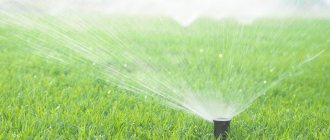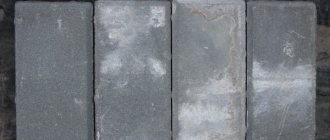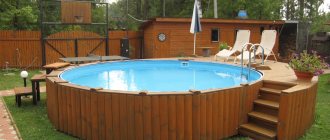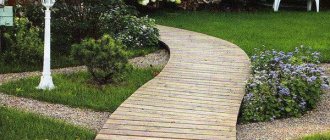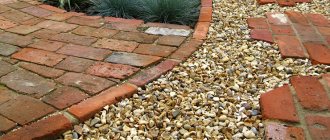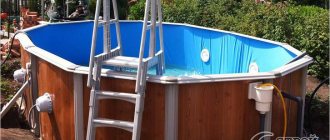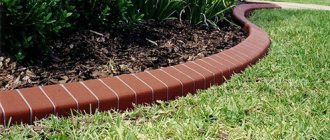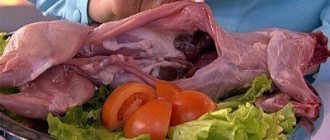When to feed hydrangeas
Nutrients are applied to the hydrangea root at least 4 times per season:
- in spring, to activate growth processes;
- during budding;
- as soon as the corollas begin to open;
- at the end of summer or beginning of autumn.
The crop responds well to foliar fertilizing - it allows for better absorption of microelements. They are given no more than once every 2 weeks; they can be given in tank mixtures with pesticides and other care products, for example, stimulants, anti-stress drugs, unless otherwise indicated in the instructions.
In summer, foliar feeding is done in the early morning or evening so that drops on the leaves do not turn into scalding lenses.
Types of fertilizing
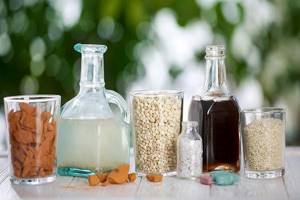
There are a huge number of types of fertilizers for hydrangea; each gardener chooses for himself what suits him best. Concentrated solutions, granules, powders, folk remedies give good results, but only when used correctly. Do not overuse fertilizing, otherwise the effect will be the opposite. From an overabundance of nutrients, the bushes wither, and flowering occurs late.
Folk remedies
At the beginning of spring, immediately after winter awakening, you can feed hydrangea with any of the following additives:
- cow dung. Dilute the litter in a 10-fold dilution with water and let it sit for at least a week. During this time, the mixture has time to ferment well. Then dilute the infusion another 10 times and pour it over the hydrangea at the root. Instead of cow manure, you can use horse and rabbit manure. If you used chicken for cooking, then it needs to be diluted 2 times more, since the substance is more reactive than the others. After a couple of days, the treatment can be repeated. The infusion of litter contains a high concentration of nitrogen compounds necessary for the development of the culture;
- kefir, whey. Hydrangea loves slightly acidified soil, so you can acidify the soil with the help of fermented milk products. Dilute 1 liter of whey or kefir in 10 liters of water and water the plant at the root. This fertilizing promotes abundant flowering of the bush;
- infusion of stale bread. The bun contains yeast, which has a beneficial effect not only on the bushes, but also on the soil. The content of beneficial soil bacteria increases in the soil, which strengthens the root system and immune qualities of plants. To prepare the fertilizer, soak a loaf of bread in a bucket of water, let it sit for several days and pour the mixture under the root without removing the crust;
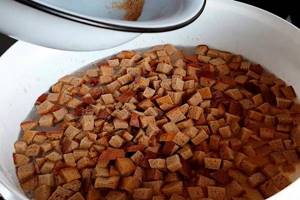
- a weak solution of potassium permanganate. Potassium promotes the formation of beautiful bright buds, and flowering itself occurs earlier than usual. Moreover, potassium permanganate is an excellent means of preventing viral diseases and pests, and the shoots and roots of the plant themselves will be absolutely healthy. It is enough to dissolve a few crystals of the dry substance in a large volume of water to obtain a slightly pink color. You cannot prepare strong solutions with a purple color, in which case the roots will be severely damaged when watering. The freshly prepared mixture is watered onto the soil near the tree trunk;
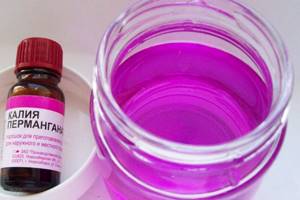
- yeast. This type of fertilizer is very similar to bread fertilizer, since it is also based on yeast. Dissolve one sachet of bulk product in a liter of warm water, add a couple of tablespoons. granulated sugar to make the fermentation process more intense. Then the dough is diluted tenfold with water and the soil near the tree trunk is watered. However, you should not feed the soil with yeast too often; over time, the composition of the soil may deteriorate.
On a note! Instead of yeast dough, you can fertilize hydrangea with fresh beer.
All folk remedies should be applied only to moist soil. When applying the concentrate to dry soil, the plants will receive serious burns, so flowering may not be expected.
Chemicals
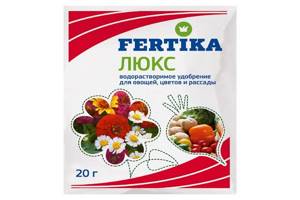
The most common fertilizers suitable for spring feeding are superphosphate, potassium sulfate, and ammonium sulfate. They can be applied from mid-spring until summer at intervals of 10-14 days. The total number of feedings should not exceed 3-4 times during the entire growing season. Any of these substances is diluted as follows: tbsp. dry matter per 10 liters of water. Water the ground near the bush with the prepared solution and loosen it.
How to Identify Nutrient Deficiencies
Hydrangea is a perennial. All macro-, meso- and microelements are important for life. Purpose of the main ones, briefly:
- nitrogen is a building material for all cells, promotes the growth of green mass;
- phosphorus is needed for the development of roots and the formation of a large number of buds;
- potassium is responsible for the quality of flowering and the color of the corollas;
- calcium helps absorb other elements;
- magnesium prevents the buds from falling off and gives brightness to the inflorescences;
- If there is not enough iron, there will be chlorosis.
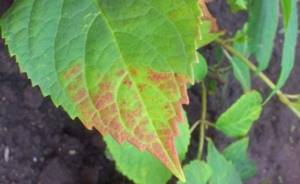
Externally, nutritional deficiency affects hydrangea as follows:
- nitrogen - starting from the veins, the leaves turn yellow, first the old lower ones, growth stops;
- phosphorus - the plates rise upward and acquire a purple tint from the inside, which is uncharacteristic for the variety;
- potassium - marginal necrosis of the leaves begins, straw dots appear in the center;
- calcium - young plates become smaller;
- magnesium – the color of the flowers is paler than indicated in the description of the variety, the buds crumble, the leaves between the veins become reddish or purple;
- manganese - chlorosis spreads from the base of the plate to the tip, the inflorescences become loose and drooping;
- sulfur – photosynthesis decreases, growth becomes straw-like;
- iron - leaves turn yellow between the veins, starting from young ones;
- copper - vegetative organs lose turgor, the tips of the plates turn white;
- boron - the buds fall off, the growth points of the shoots become curled;
- molybdenum - marks appear on old leaves that turn into swellings;
- zinc - expressed in the bronzeness of the plates, the petioles take a vertical position.
Why fertilize hydrangea in spring and summer
For growth and flowering, hydrangeas need a set of macro- and microelements:
- Nitrogen is necessary for the active growth of shoots and green mass.
Important! If there is an excess of nitrogen, the hydrangea will begin to form a lot of greenery, so flowering will be sparse.
- Phosphorus is needed for lush and long-lasting flowering, as well as for growing the root system.
- Potassium is necessary in spring and summer during budding and flowering, as well as in autumn for laying flower buds for the next year and preparing flowers for wintering.
- Each microelement is responsible for certain processes in plants. For example, magnesium is essential for bud set and vibrant bud color.
- Iron is also needed by hydrangeas. If there is a shortage of it, the shrub may develop chlorosis, to which these flowers are prone.
In spring and summer, fertilizing hydrangea gives the following positive results:
- Rich green leaves without chlorosis.
- Stimulates the formation of buds.
- Increases flowering duration.
- Enhances the splendor and volume of flowers.
- Improves the color of buds.
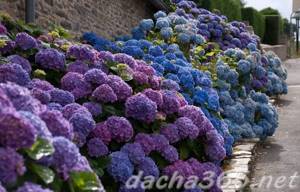
By receiving all the macro- and microelements, hydrangea gets sick less, becomes more resistant to temperature changes, lack and excess of moisture, as well as to various stresses.
Important! Hydrangeas do not need to be fertilized for 2-3 years after planting if all the necessary fertilizing was initially applied to the holes.
Types of fertilizers
To feed hydrangeas, specialized mineral fertilizers with microelements are sufficient. Organics and folk remedies, if the preparations are good, are applied on time, may not be used at all.
Mineral
In spring, hydrangeas need nitrogen. If it is given after pruning, you can use any preparations containing the element; for snow - selectively, preferably saltpeter. In autumn, nitrogen, on the contrary, is not needed so as not to provoke the growth of the bush. Hydrangeas are given potassium monophosphate or Pekacid.
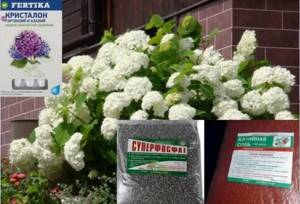
In summer, it is recommended to use complex preparations containing microelements plus an NPK complex. Fertilizers are suitable for rhododendrons and hydrangeas. You can take fertilizers for coniferous crops if the packaging is marked “summer” - there is little nitrogen there.
It is recommended to pay attention to specialized fertilizers for hydrangeas TM:
- Fertika Crystallon;
- ASB Greenwald;
- Pokon;
- Kemira;
- Agricola;
- Bona Forte;
- Florovit;
- Green Boom;
- Biopon;
- Planton,
- Master.
Among mineral fertilizers there are preparations that tint large-leaved hydrangeas blue or light blue. This should be indicated on the packaging.
Organic
Fertilizing with mullein infusion, bird droppings, and green fertilizer is not suitable for the crop. The exact composition there is unknown, it depends on too many factors, and hydrangea is already capricious. It’s better not to take risks, use mineral fertilizers, or organic matter sold in stores, designed specifically for hydrangea TM:
- Ecostyle;
- Organic Mix.
Color change
Experimenting with flower shades is only permissible with large-leaved hydrangea (Hydrangea macrophylla). This is due to the content of anthocyanins in the cell sap of the petals. The specific shade depends on what these special substances are combined with and in what environment they are found.
The “variability” pigment is present only in the petals of blue and pink species. Other varieties of hydrangea are not able to change their color under the guidance of a gardener. In some varieties of this plant, the shades of the panicles change during life, but it is impossible to artificially influence this process.
For example, the Pink Diamond type of paniculate hydrangea blooms with white panicles in the summer, and in the fall they independently acquire a pink tint.
How to make blue?
You can paint hydrangea flowers in blue tones if 2 conditions are met:
- The soil pH (pH) should be slightly acidic: 5.2-5.5. To determine the pH, it is necessary to do a soil analysis and, if necessary, reduce it by adding aluminum sulfate.
- The soil composition must contain aluminum. If this chemical element is present in the soil and the pH is low, then the hydrangeas have probably already turned blue.
Video on how to make hydrangea blue:
How to make it pink?
Hydrangeas can turn pink due to aluminum deficiency. This element can be removed from the soil as follows:
- Raise the soil pH to 6.0-6.5 by adding lime with magnesium oxide (dolomite mixture). In this interval, hydrangeas cannot obtain aluminum from the soil and at the same time they do not suffer from an insufficient amount of chlorosis and other nutrients.
- For hydrangeas, use those types of fertilizers that are high in phosphorus, which prevents plants from obtaining aluminum.
- Water blue hydrangea 2 times every 7 days with a weak solution of potassium permanganate. This procedure must be performed before the period of bud formation begins, that is, in the spring. In summer the bush will bloom pink.
It is impossible to make the blue or pink color more saturated by adding additional additives to the soil.
The color of plants can change depending on the season, with changing weather conditions, as a result of stress experienced by hydrangeas, and also due to environmental conditions. Thus, specimens growing near concrete objects will never acquire a blue color due to the presence of lime washed out of the concrete.
Schemes for feeding hydrangea with fertilizers
The drugs and crops needed at different periods of development differ in composition and action. In spring, nitrogen is needed, in summer - a complete mineral complex, microelements, in autumn - phosphorus and potassium.
Upon landing
It is not necessary to add hydrangea starter fertilizer to the hole. But its introduction will save owners from the need to feed the crop for at least half the season.
In addition, for example, superphosphate tends to act not immediately, but after a few months, but it works for up to 3 years. To satisfy the needs of hydrangea, a glass of this fertilizer is added to the planting hole, plus 30 g of potassium sulfate, mixed with soil.
How to feed hydrangea in spring
At the beginning of the season, the crop needs nitrogen, especially after short pruning. The shrub needs to grow stems that can withstand numerous flower caps, and leaf apparatus that ensures their vital functions. This will not work without complete nitrogen fertilization.
All hydrangeas, except Large-Leafed (which are still under cover at this time), can be given fertilizer in the snow. Calcium or ammonium nitrate are more suitable for this purpose.
During budding
For hydrangea to produce large, beautiful, well-colored inflorescences, pruning alone is not enough. The bush needs feeding.
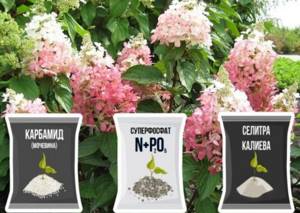
Complete mineral fertilizer with microelements is given at least 2 times:
- as soon as the buds begin to form;
- when the first corollas open.
Potassium, phosphorus and magnesium are considered to be the “fusers” of color. In garden hydrangeas overfed with nitrogen, the corollas retain a greenish tint longer, but pink, red, and lilac will be pale, with a salad tint.
Autumn feeding of hydrangeas
At the end of the season, the crop needs phosphorus and potassium. Nitrogen is not given at all - it can stimulate a new wave of growth. As a result, the shrub will end the season weakened, with immature wood and young, fragile tips of the shoots.
Fertilizers help prepare hydrangea for winter and lay the foundation for future flowering. The use of drugs gives good results:
- Pekacid;
- potassium monophosphate.
Feeding is done:
- in the south - at the beginning of autumn, until the temperature has dropped to 15° C;
- Middle zone and more northern regions - end of summer or first days of September.
Foliar feeding
Fertilizers applied along the crown begin to act quickly and are removed just as quickly. Microelements are better absorbed through the leaves, especially metal oxides, the deficiency of which causes chlorosis in sensitive hydrangeas.
You can spray hydrangeas with a nutrient solution every 2 weeks. Better - alternately with a chelate complex and a complete mineral fertilizer with microelements.
During flowering, it is recommended to stop processing, otherwise the decorative effect will be significantly reduced.
Feeding hydrangeas with folk remedies
When growing hydrangeas in containers, it is recommended to abandon unconventional methods other than hydrogen peroxide. Even if their use is acceptable, and the reviews are only good. Any mistake will lead to problems or death of the plant.
Potassium permanganate
Manganese is involved in redox reactions, strengthens wood, and helps large inflorescences keep their shape. It is especially important to give a weak solution of potassium permanganate to varieties of paniculate hydrangea such as Vanilla Fraze with huge, heavy, dense cones.
The drug is first diluted in a separate container so that all the crystals disperse, then a solution so pale pink is prepared that its color is visible only against a white background. If you make it more concentrated, the bushes may burn. At best, only the inflorescences will suffer.
During May, garden hydrangeas are given potassium permanganate 2-3 times. A bucket of solution is poured under each bush.
Hydrogen peroxide
This is not a supplement, but a stimulant. Used when the plant has problems absorbing oxygen. If hydrangea is okay with this, the drug does neither good nor harm. You can water the bush once every 14 days, spray the crown every week, not more often.
Working solution:
- water – 1 l;
- hydrogen peroxide – 2 tbsp. l.
Other means
Baker's yeast can be a source of nitrogen, a stimulator of growth and immunity. Concentration per 10 l – 100 g pressed or 2 tbsp. l. dry. Allow to ferment, use the same day - pour hydrangea under the root or process one leaf at a time.
Boric acid (0.5 g per 1 liter of water) is used for spraying when hydrangea buds fall off and the growing points become curly. Usually one treatment is sufficient.
Features of fertilizing hydrangeas
Spring, summer and autumn feeding of hydrangeas differ slightly in the composition of mineral-organic mixtures, timing and dosage of their application.
The correct combination of components not only improves the decorative appearance of the bush and affects the splendor of flowering, but also protects against various diseases to which weakened bushes are susceptible. This includes leaf chlorosis, gray rot, and spider mite infestation. Therefore, regular procedures should be treated responsibly, not forgetting to purchase or prepare nutrient solutions on a monthly basis.
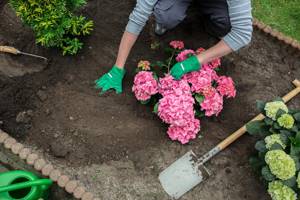
in spring
Caring for hydrangeas in the spring and feeding them are aimed at laying buds, forming green mass and intensive growth of the bush. This requires a lot of nitrogen, so the main drugs during this period are potassium sulfate and a mixture of urea. They are diluted with a tablespoon of each in 10 liters of water, and half a bucket is poured under each bush. Hydrangea responds well in spring to slurry diluted with water in a ratio of 1:10.
During budding, the shrub requires other nutrients, so components rich in phosphorus and potassium are added to the hydrangea “diet”. Most often, they purchase superphosphate or a complex mineral preparation containing the necessary elements in stores.
When thinking about how to fertilize hydrangea in the spring, you should not ignore the potassium permanganate solution. The pinkish liquid is watered not only on the soil, but also on the branches and crown of the bushes, trying to produce about three full-fledged feedings per season.
In summer
Summer feeding of hydrangea for active flowering includes the use of both organic and complex mineral fertilizers. Store-bought ones include Kemira Flower, Agricola, and nitrophoska, diluted according to the instructions on the package.
It is also recommended to fertilize the soil with natural organic matter - diluted slurry, infused in a barrel for about two days, or an infusion of nettle leaves, chicken droppings diluted in water.
It is important to know. Typically, in the summer, hydrangeas are fertilized no more than three times per season, so one fertilizing per month is sufficient. Experienced gardeners also water the bushes with kefir, yogurt, whey, and a solution of potassium permanganate. Such nutritional procedures activate leaf growth, lengthen flowering periods and increase the number of inflorescences.
in autumn
You need to feed hydrangea in the fall to prepare for the upcoming winter, so that the root system and branches with buds can survive the frosts. The shrub no longer needs nitrogen, it causes the growth of new shoots, but potassium and phosphorus can still be added in early September to protect the roots from freezing. Usually they mix a spoonful of superphosphate and potassium sulfate, fill it with a bucket of water, and pour it over each bush.
It is equally important to use organic ingredients to feed hydrangeas in the fall. Each bush should be covered around the perimeter with humus, peat, and the soil should be covered with sawdust or pine needles. As it decomposes, such mulch will nourish the plant and act as insulation in the winter.
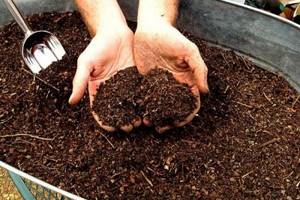
How to acidify soil for hydrangeas
If you apply fertilizers to alkaline soil, the crop will constantly lack nutrients. Large-leaved hydrangea suffers especially badly. According to reviews, Drevovidnaya tolerates even weak liming, but it is better not to carry out such experiments.
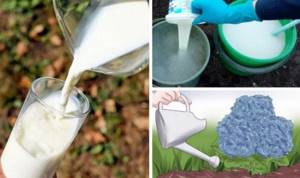
You need to acidify the soil 1-2 times a month, depending on the composition of the substrate and the pH level requirements of the type of garden hydrangea:
- The most common practice is to feed hydrangeas with citric acid. If you add 1 tsp. on a bucket of water, you definitely can’t harm the plant. On neutral or alkaline soil this may not be enough, especially for large-leaved hydrangea. The maximum permissible dosage is 2 tbsp. l. on a bucket. You need to choose the concentration for each site and type of hydrangea individually.
- Wine vinegar – 100 g per 10 l.
- Infusion of sorrel or rhubarb. Half a bucket of leaves is poured with water overnight, the next day a liter jar of infusion is diluted with 10 liters of liquid, and the bushes are watered.
- Homemade wine - 200 g per bucket. Store bought cannot be used.
- Feeding hydrangeas with kefir (2 liters per 10 liters of water), in addition to acidifying the soil, enriches the soil with beneficial bacteria.
Spring, summer, autumn feeding: terms and rules

Hydrangeas prefer slightly acidified soils. Large-leaved hydrangea also develops well in neutral soils (pH about 7). Creating favorable conditions for the plant begins already at the planting stage. The planting hole is made voluminous, 20-25 cm larger in all directions than the size of the root system. If the soil on the site is not acidic, add peat or pine needles. Fertilizers include superphosphate (a glass), potassium sulfate (30 g), and during spring planting, additionally ammonium sulfate (30 g).
For the first two years, it is recommended not to feed the plant. In the future, the application of mineral fertilizers is alternated with organic matter. With all the variety of regimens and drugs, the general rules are as follows:
- nitrogen fertilizing is applied from spring to mid-summer (every two weeks)
- to strengthen tissues, it is useful to water the bush with a solution of potassium permanganate once a month (0.2 g per bucket of water)
- from mid-summer the nitrogen supply is stopped
- during the budding period and further fed with fertilizers with a predominance of potassium
- from the end of August all feeding stops
Interesting! Some gardeners advise feeding hydrangea with complex mineral fertilizer in a diluted concentration for the first few weeks after planting. This applies to those seedlings that arrived from Holland and were kept under drip irrigation. With this method of cultivation, the roots of the plant are not adapted to take nutrients from the soil, and a sudden change in the maintenance regime can seriously undermine the immunity of the seedling. With the help of supplements, the transition to normal nutrition will be more gentle.
Hydrangeas are responsive to fertilizers. If it is not possible to apply them regularly, you can apply complex granular fertilizers to the soil once in the early spring immediately after the snow melts, which will be used up gradually and provide the plant with mineral nutrition for the entire season (or even 2-3). In this case, additional mineral fertilizing should not be carried out!
Important! An interesting feature of large-leaved hydrangea is its ability to change color depending on the composition of the soil.
The inflorescences will turn from pink to blue if you water the bush with a solution of potassium alum (5 g per 1 liter of water). 2 liters of solution is enough for one plant. You can also use special preparations to change color, which are now sold in any gardening store. The procedure is carried out every two weeks, starting from the period of bud formation. This transformation can be done, for example, with the following varieties of large-leaved hydrangea: Blaumeise, Nikko Blue, Bodensee. White varieties do not change their color.
How not to fertilize hydrangeas
Sometimes gardeners, in an effort to “do what is best,” make life difficult for themselves. Instead of using fertilizers recommended for hydrangeas, they add drugs or folk remedies that are unacceptable for the crop.
You cannot fertilize hydrangea:
- unripened compost;
- fresh manure (not completely rotted);
- bird droppings;
- pig waste in any form, no matter what age;
- ash;
- chalk;
- lime;
- dolomite flour;
- fertilizers that alkalize the soil;
- fertilizers containing chlorine.
How to properly feed hydrangeas for lush flowering
Basic recommendations:
- Within a radius of 15-20 cm from the trunk of the plant, you need to make a small groove where fertilizers will be applied in dry and liquid form.
- After fertilizing the furrow, it is recommended to sprinkle it with compost or humus, or better yet, acidic peat. This will be mulch and additional nutrition).
- Before fertilizing, the bushes are watered, since fertilizers are applied to moist soil, especially mineral ones.

Interesting! If it rained the day before and the ground is wet enough, no watering is carried out.
Advice! The soil must be watered 2 hours, or better yet, a day before applying fertilizer.
- Fertilizing is carried out in the morning or evening, when the sun is not at its zenith. If the weather is cloudy, this can be done during the day.
- In spring, root feeding is carried out. In dry form, spreading fertilizers into the furrows, they will dissolve and be absorbed into the soil when watering. Or in liquid form, making a solution according to the instructions. And in the summer they spray.
Important! Foliar feeding is considered most effective when there is a shortage of any nutrients. However, they do not replace root ones and are additional.
- Fertilizer proportions are taken according to the instructions. Don't rely on memory.
Fertilizers for acidifying the soil and changing the color of hydrangeas
The soil in which hydrangea grows must have an acidity of 5-6.2 pH, so it must be acidified periodically (every 15-30 days during flowering).
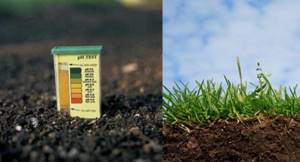
Important! Hydrangeas in alkaline soil practically do not absorb nutrients. Therefore, there is no need to fertilize flowers with ash and other deoxidizing agents.
For acidification use:
- Electrolyte (1 ml per 1 liter of water).
- Apple cider vinegar 9% (10 ml per 1 liter of water).
- Citric acid (2-4 g per 1 liter of water).
Advice! Additionally, iron chelate or iron sulfate (2-3 g per 1 l) must be added to the solutions.

Fertilizers for acidifying the soil and changing the color of hydrangeas
The color of hydrangeas can be changed by changing the acidity of the soil. The principle is this: the more acidic the soil (5-5.5 pH), the more purple or blue the buds will be. Conversely, the lower the acidity (6-6.2 pH), the more crimson or pink the flowers will be.

To deoxidize the soil, dolomite flour, wood ash, and fluff lime are used.
Important! You can turn blue hydrangeas into pink ones, but the reverse is not so easy. Even with strong acidity of the soil, enough mobile aluminum is needed to change color.
You can additionally add a solution of potassium alum:
- 30-40 g of product;
- 10 liters of water;
- For 1 bush 2-3 liters of solution.
You can also add aluminum sulfate to the soil (up to 500 g per 1 square meter).
Watch the video! Hydrangea - blue or pink? How to change the color of a hydrangea
You can also use special ready-made fertilizers to change the color of hydrangeas:
- Bona Forte in liquid form.
- Bona Forte powder;
Advice! White hydrangeas do not change color.
General information about fertilizing for hydrangea
Regular fertilization will provide the hydrangea with the necessary nutrients, which will undoubtedly affect the appearance and general condition of the plant.
In this case, the bush will grow and develop with good intensity, bloom luxuriantly and abundantly until late autumn.
Complex fertilizers for hydrangea will make it strong and strong, which, in turn, will help it survive the winter cold.
But if you do not pay due attention to fertilizing, the hydrangea will become “sad,” general lethargy and weakness will appear in the branches, yellowness will appear in the foliage, the buds will stop blooming, the flowers will become smaller and smaller, their color will become faded and dull.

In addition, there will be susceptibility to diseases and various parasites.
When attacked by pests, the plant simply may not have enough strength to fight them, and it will die.
To prevent all of the above and get a beautiful, healthy and flowering bush, do not forget about timely application of fertilizers.
Spring feeding of hydrangea is very important.
